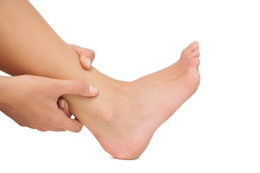Most of the sportsmen do suffer from inversion ankle sprain at least once in their life. Often it is neglected as a minor injury, but neglecting the injury can have serious side effects as well.

Sudden twisting of the ankle on any side causes ankle sprain. It can be caused during one of the sporting activities or also due to day-to-day activities. One of the most common of the ankle sprain injury is the inversion ankle sprain. Of the total number of ankle sprains, as many as 70 to 85% of the ankle injuries are inversion injuries. It is commonly seen in athletes. It is caused when the foot is forced to turn inward awkwardly. When the foot turns inward, it is beyond ligaments and muscular control.
Inversion Ankle Sprain Injury
Causes
If ankle sprain is caused while walking, it is often caused due to taking an awkward step. Walking on uneven surfaces can also cause the ankle to twist in an awkward angle. If during playing or running or jogging a person lands on an uneven surface, the ankle may be twisted inwards. Sometimes, it may also be caused when one steps on someone's foot accidentally. If while walking one does not pay attention and steps on a curb or slips due to presence of water or ice on the floor, the foot may be twisted inwards.
Symptoms
This is an injury that is caused to the ligaments in the ankle. More often than not the ankle is stretched way beyond its capacity and it can lead to the ankle been worn out. Often it is ligaments located to the outer side that are severely affected with this injury. The symptoms of the condition often depend on the extent of the injury. In some cases, pain in the medial and lateral area of the ankle will be seen. In some cases, patients complain about ankle pain but no swelling. This pain is observed on the outer side of the ankle and there will be no pain observed on the inner side of the ankle. Bruising around the ankle joint is one of the most common symptom of this condition as well. The damage caused by the injury depends on the degree of injury. The grade I injury is the one, where only a few ligament fibers may be damaged. The patient may find it difficult to walk, but nonetheless is able to walk. In grade II injury, there is extensive damage caused to the ligament and swelling of the ankle joint is observed. Grade III is a serious kind of an injury, where there may be ligament rupture accompanied by swelling and joint dislocation.
Treatment
The treatment for the condition depends on the extent of damage caused by the injury. The first 48 hours are said to be crucial in this injury. It is important to use the R-I-C-E method for treating the ankle.
Rest the ankle joint by placing the leg on an elevation. This will also help in reducing swelling of the ankle joint.
Ice packs should be applied to the affected part. It will help in reducing pain and swelling from the affected part. However, make sure you do not apply ice directly to the affected part. It should always be applied placed inside a cotton cloth. Repeat the ice packs for 10 to 20 minutes every 2 hours. Use
compression bandages to protect the ankle joint. At the same time, make sure that a lot of pressure is not exerted on the ankle joint. It is best to keep the leg on an
elevation as much as possible. After the ankle has recovered from the trauma, ankle exercises may be prescribed to the patient by the physiotherapist. It is important that one does not choose the exercises on their own to avoid complications.
After an ankle sprain injury, if the swelling refuses to go away in a day or two, then without wasting any time, it is best to consult an orthopedic surgeon. An X-Ray may be required to determine the exact extent of the injury. In some cases, hairline fracture may also be caused to the ankle joint.


 Sudden twisting of the ankle on any side causes ankle sprain. It can be caused during one of the sporting activities or also due to day-to-day activities. One of the most common of the ankle sprain injury is the inversion ankle sprain. Of the total number of ankle sprains, as many as 70 to 85% of the ankle injuries are inversion injuries. It is commonly seen in athletes. It is caused when the foot is forced to turn inward awkwardly. When the foot turns inward, it is beyond ligaments and muscular control.
Sudden twisting of the ankle on any side causes ankle sprain. It can be caused during one of the sporting activities or also due to day-to-day activities. One of the most common of the ankle sprain injury is the inversion ankle sprain. Of the total number of ankle sprains, as many as 70 to 85% of the ankle injuries are inversion injuries. It is commonly seen in athletes. It is caused when the foot is forced to turn inward awkwardly. When the foot turns inward, it is beyond ligaments and muscular control.